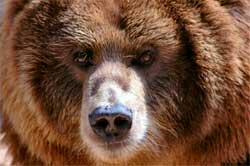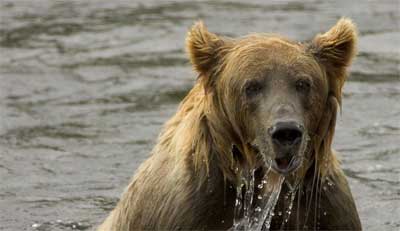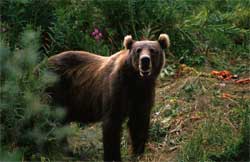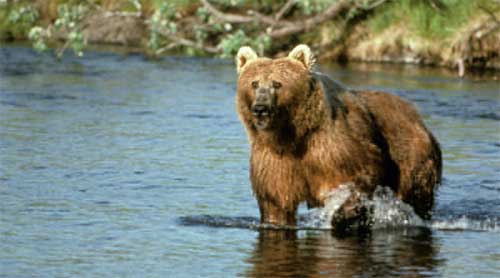|

 Big & Mean: Kodiak bears are indigenous to the Kodiak Islands off the southern coast of Alaska. Males (or boars) can reach 1,500 lbs and stretch to over 10ft, while females (or sows) are generally smaller. They have long sharp claws, used for ripping open their captured prey and digging. Their coats are brown and fluffy, and thick enough to protect them throughout the cold Alaskan winters. Like other Brown bears, the Kodiak bear has a massive hump of muscle over its shoulders that assists them in digging and stores the power exercised in their deadly blows. Big & Mean: Kodiak bears are indigenous to the Kodiak Islands off the southern coast of Alaska. Males (or boars) can reach 1,500 lbs and stretch to over 10ft, while females (or sows) are generally smaller. They have long sharp claws, used for ripping open their captured prey and digging. Their coats are brown and fluffy, and thick enough to protect them throughout the cold Alaskan winters. Like other Brown bears, the Kodiak bear has a massive hump of muscle over its shoulders that assists them in digging and stores the power exercised in their deadly blows.

Kodiak bears will eat almost anything, but throughout most of the year their diet consists primarily of vegetation. They will hunt land animals, but usually prey only upon the sick or elderly of these. They prefer not to chase an animal, since their size slows them down. Although it must said that for their size they are quite athletic and can run quickly over short periods. If they kill an animal that is too large for them to consume in one sitting they’ll hide the meal from scavengers and return to it when ready.
Stop Pawing: Perhaps their favorite food is salmon. They seem to take pleasure in the hunting of these fish and can easily consume over 80 lbs in a day. Each bear seems to have a different hunting method, but the most common is for the bear to jump into the salmon-filled water and claw in the river to grab some fish. If the bear is near an area where the salmon happens to be jumping high enough out of the water, the Kodiak bear will try and catch the fish in mid-air.
A Deep Sleep: The peak season for salmon comes in July and August, and the bear begins to consume about 50% more food then it had been in the spring. This is the bear’s way of preparing for winter. In about November, the bears will begin to enter their dens for hibernation. But they do not hibernate in the popular sense. That is, they do not sleep throughout the winter, and they do not enter their dens to protect themselves from the cold. Their coats would be sufficient for this task. Rather, they enter hibernation because there is not sufficient food to sustain them throughout the winter. Hibernation is a way to conserve energy. But during hibernation, they are relatively active. They are aware of their surroundings, will awaken and even attack if an intruder enters the dens, sows will give birth and care for the cubs, and some bears will leave the den, but do stay close by.
 Stretch the Legs: They emerge from their dens starting in about March and April and begin foraging for food. By July, they have established fishing spots. This can sometimes lead to fights, especially between males. Fights are often simply displays of dominance but can be physical. These can be violent and may lead to serious injury. Kodiak bears have a sort of body language and trained observers can translate their gestures. When a bear is angry it will sometimes bounce on its front feet, indicating that a fight may be brewing. But an important part of the bear psychology is the bluff, and it seems the bears first hope is always to scare off an intruder, even if it is human. Stretch the Legs: They emerge from their dens starting in about March and April and begin foraging for food. By July, they have established fishing spots. This can sometimes lead to fights, especially between males. Fights are often simply displays of dominance but can be physical. These can be violent and may lead to serious injury. Kodiak bears have a sort of body language and trained observers can translate their gestures. When a bear is angry it will sometimes bounce on its front feet, indicating that a fight may be brewing. But an important part of the bear psychology is the bluff, and it seems the bears first hope is always to scare off an intruder, even if it is human.

A Proud Mother: Sows reach sexual maturity at about 5 or 6 years of age. Generally, they mate with older males, but only because older males are dominate and prevent the younger males from mating. Sows give birth to 1-3 cubs, which weigh only about 1 lb each. They remain attached for a few years, until the mother drives them off in preparation for another litter. Kodiak bears, like many other animals, experience delayed implantation.

All text is available under the terms
of the GNU Free Documentation License
|